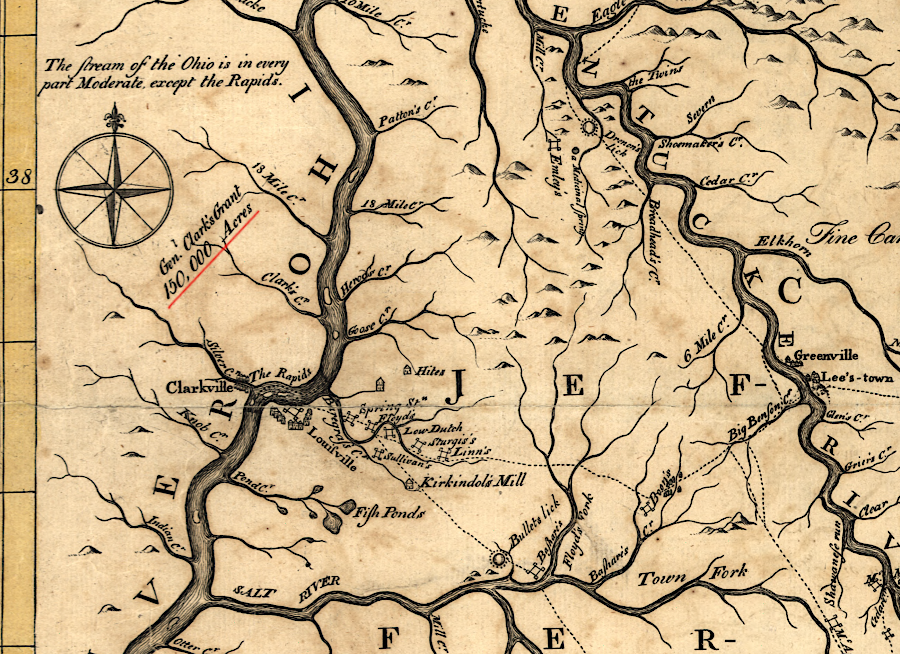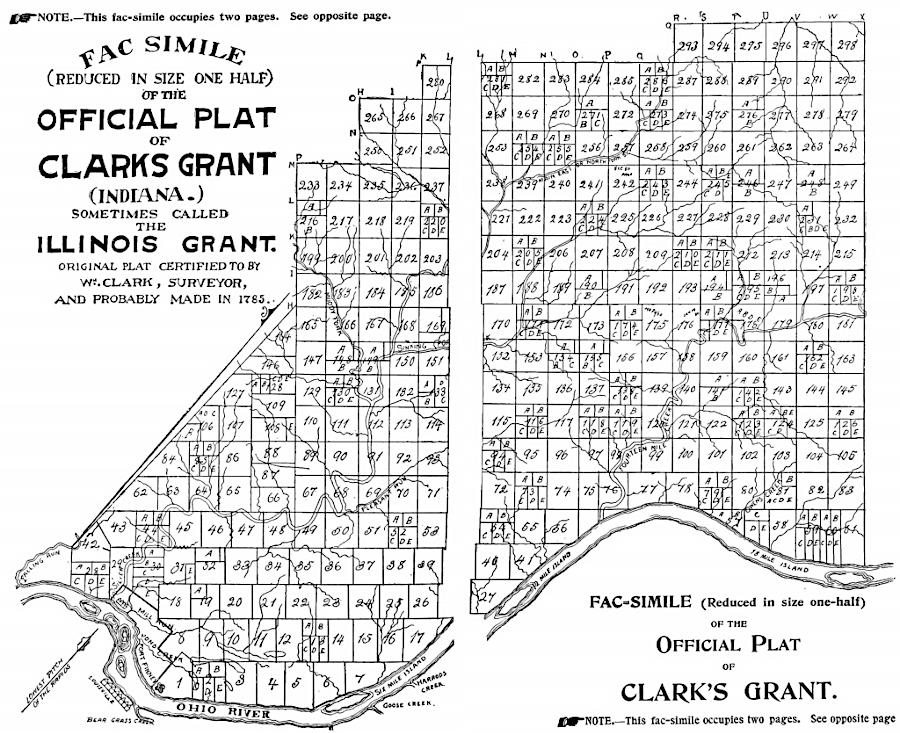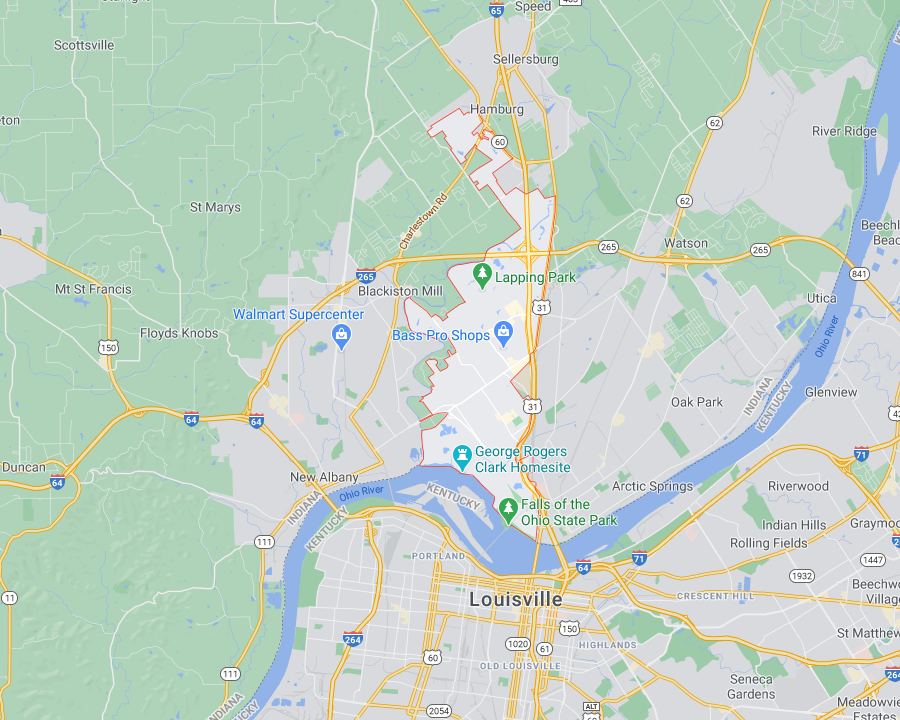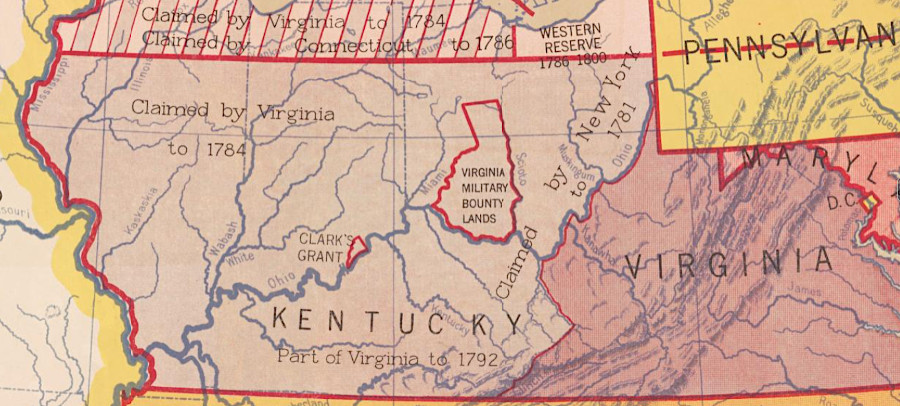
the General Assembly designated 150,000 acres north of the Ohio River for land grants to qualified members of the Illinois Regiment
Source: University of Nebraska-Lincoln, The Discovery, Settlement and Present State of Kentucke (John Filson, 1784)

the General Assembly designated 150,000 acres north of the Ohio River for land grants to qualified members of the Illinois Regiment
Source: University of Nebraska-Lincoln, The Discovery, Settlement and Present State of Kentucke (John Filson, 1784)
At the start of 1778, George Rogers Clark was given a secret assignment to capture the British forts northwest of the Ohio River. He was authorized to promise a 300-acre land grant to anyone willing to serve in the Illinois Regiment, as an extra incentive to recruit that military force. The mission required a difficult march across the wilderness before seizing the British forts.
Clark and his 175 men in the Illinois Regiment succeeded in capturing Kaskaskia, Cahokia, and Vincennes, though he could not gather enough men and supplies to attack Detroit. The British reoccupied Vincennes, but Clark recaptured it and seized the British commander for the region.
Lieutenant Governor Henry Hamilton and about 25 other British captives were marched back to Williamsburg, causing great satisfaction among the state officials there. The Illinois Regiment's successful expedition and occupation of the land north of the Ohio River led to Great Britain ceding its claims to the Northwest Territory in the 1783 Treaty of Paris, which ended the American Revolution.1
The General Assembly honored the secret promise to award land grants to the men in the Illinois Regiment. On January 2, 1781, the legislature authorized the officers to identify a 150,000 acre tract north of the Ohio River, from which parcels would be surveyed for those who qualified. Paperwork asserting a claim to a grant had to be submitted by April 1, 1784.
Clark's Grant ended up in Indiana across the Ohio River from Louisville, Kentucky. That grant is separate from the two military districts established by Virginia for soldiers to claim land for their service in the Revolutionary War. Land for a Virginia Military District was set aside in western Kentucky in 1779, before Kentucky became an independent state. Another military district was reserved in 1784 when Virginia ceded its claims to the Northwest Territory; the 1784 district ended up in the state of Ohio.2

the General Assembly allowed the Illinois Regiment officers to determine the location of 150,000 acres north of the Ohio River for land grants
Source: HathiTrust, Conquest of the country northwest of the river Ohio 1778-1783; and life of Gen. George Rogers Clark (by William Hayden English, 1896)
The General Assembly designated the officers of the Illinois Regiment as the board of commissioners who would determine which soldiers and officers were eligible for land grants, and how much acreage each person would receive.
In 1783, the General Assembly modified the terms and required that a 1,000-acre parcel of the total 150,000 acres be surveyed into 1/2 acre lots for the town of Clarksville. The legislature named the first ten trustees for the new town, and assigned the trustees the responsibility for selling the 2,000 lots. There was no requirement for the trustees to live in Clarksville, and when one died or resigned the other trustees replaced him without local elections. Not until sometime after 1889 were the trustees required to live in the town and be elected by town residents.3
The remaining 149,000 acres of the Clark's Grant were distributed only to members of the Illinois Regiment. Revolutionary War soldiers who served in other Virginia units were eligible for lands in the two Virginia Military Districts, but not in Clark's Grant.
Officers of the Illinois Regiment determined that grants would be awarded only to those soldiers and officers who had enlisted in the Illinois Regiment prior to January 2, 1781, and had served for three years or to the end of the war.4

where George Rogers Clark retired to live in Clarksville is now part of the Falls of the Ohio State Park
Source: GoogleMaps
Five surveyors defined the boundaries of the tracts to be conveyed to the soldiers and officers, and whenever they made mistakes the surveys typically provided extra land to the claimant. The commissioners determined how much would be awarded to the 64 officers and 236 privates. George Rogers Clark was given over 8,000 acres, and all officers were granted over 2,000 acres each.
The 1783 legislation stated that claimants were required to pay $1 per 100 acres granted and that "no lot or survey shall exceed five hundred acres," but evidently officers could claim multiple surveyed parcels. Soldiers and officers could sell their warrant (right to claim land) to creditors and land speculators, and descendants could inherit the rights.
The hierarchical nature of society at the time was reflected in the land allocations - 123,512 acres distributed among the 64 officers, and 25,488 acres distributed among the 236 privates. Privates each got 108 acres, less than the 300 authorized in 1778. The officers who served as the board of commissioners approved the following land grants:5
1 Brigadier-General - 8,049 acres total
1 Lieutenant-Colonel - 4,851 acres total
3 Majors, (4,312 acres each) - 12,936 acres total
14 Captains (3,234 acres each) - 45,276 acres total
20 Lieutenants (2,156 acres each) - 43,120 acres total
23 Sergeants (216 acres each) - 4,968 acres total
1 Ensign - 2,156 acres total
1 Cornet - 2,156 acres total
236 Privates (108 acres each) - 25,488 acres total

Clark's Grant, 150,000 acres rewarded to members of the members of George Rogers Clark's expedition that captured Vincennes in 1779, ended up in the state of Indiana
Source: Library of Congress, State claims, 1776-1802 (Hart-Bolton American history maps, 1917)